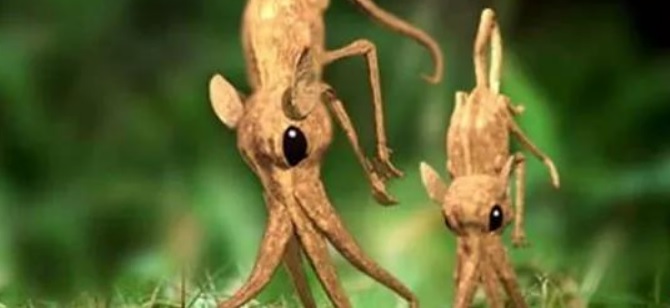Appearance[]
- Snouters: The Nasobeme is the most representative species of the oddball mammal order known as Rhinogradentia, a.k.a. "Snouters".
- Average height: 90 cm
- Tail length: Impressively, up to 3.6 meters when fully inflated.
- Nose-walker: This fancy-looking creature possesses two pairs of elongated, tentacle-like noses (the modified nasarium organ, characteristic of all Snouters) protruding from its face; which are used for locomotion.
- Inflatable tail: Its boneless hollow tail is both inflatable and dexterous, being primarily used for both manipulating food and communicating with others.
- Arms are relatively long and slender.
- Legs are severely atrophied.
Biological traits[]
- Marsupial: Newborn Nasobemes are carried in a marsupial pouch located near the adult's throat.
- Tentacular snouts
- Controlled by extremely complex nasal musculature.
- Rigid and durable, thanks to the torpor generated by the corpora spongiosa.
- Highly-developed internal air passages create a sophisticated pneumatic system, giving it flexibility and resilience.
- Expanded tear ducts are used for breathing.
- Inflatable hollow tail
- Prehensile: used to collect fruits from tree branches and bushes; as well as to grab branches and swing over obstacles or away from predators.
- Can be inflated or deflated by gases produced by the animal's digestive metabolism; making it both lightweight and versatile.
- Acute eyesight
Habitat[]
- Island or coastal habitat: inhabits the forests of the Hy-yi-yi archipelago, in the Pacific Ocean.
- Since the islands have been destroyed by atomic tests, it's likely that the species has become extinct.
- It should be noted that this animal's earliest known mention in European literature comes from a 1905 poem by Christian Morgenstern, which predates the official discovery of the islands by 36 years: a fact that has puzzled researchers.
Behaviour[]
- Herbivore: Specifically, they are frugivorous.
- Social: Nasobemes live in small groups.
- Diurnal: This species is mostly active during the day.
- Docile and unafraid of humans.
- Monogamous: They mate for life.
- K-strategist: Nasobeme mothers will typically bear a single offspring per year.
- Intelligent: Research proves that these creatures are capable of fairly advanced insight and reflection.
Morphs and subspecies[]
- Greater Nasobeme (Nasobema lyricum)
- Bluenosed Nasobeme (Nasobema aeolus)
- Small Nasobeme (Stella matutina)
- At least three other species (unnamed)
Related species[]
- The Predatory Nasobeme (Tyrannonasus imperator) is a similar species that evolved from frugivorous to carnivorous and now preys on its fellow nose-walkers.
Gallery[]
Featured in[]
- Das Nasobēm, by Christian Morgenstern (1905)
- Bau und Leben der Rhinogradentia, by Gerolf Steiner, a.k.a. "Harald Stümpke" (1957)




